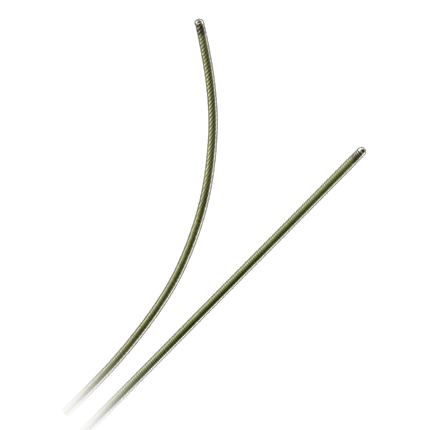TigerWire™ steerable guide wires are stainless steel supportive workhorse guide wires designed for exceptional steering.

Peripheral Guide Wire Versatility And Choice
Flexible Tip Design
- Soft atraumatic tip enables safe access to target lesions with 7 cm distal (tip) coil stretch
Various Levels of Support
- Supportive guide wire design for efficient tracking and positioning in tortuous vasculature1
- Flexible tip length that transitions from flexible to full body stiffness: standard = 5 cm, floppy = 12 cm
- Multiple tip and support designs: floppy, angled; floppy, straight; standard, straight
Versatile Products and Options
- Multiple tip configurations to meet a variety of clinical needs
- Multiple guide wire lengths of 150 cm, 180 cm, 260 cm, 300 cm
Ordering Information
| PRODUCT | PART NUMBER | DIAMETER | LENGTH | DESCRIPTION | FLEXIBLE TIP LENGTH | COIL STRETCH LENGTH | CORE TAPER | RADIOPAQUE TIP MARKER |
|---|---|---|---|---|---|---|---|---|
| TigerWire™ | C405084 | 0.035 in | 300 cm | Floppy, Angled | 12 cm | 7 cm | 24 cm | 1 cm |
| TigerWire™ | C405085 | 0.035 in | 260 cm | Floppy, Exchange, Angled | 12 cm | 7 cm | 24 cm | 1 cm |
| TigerWire™ | C405086 | 0.035 in | 180 cm | Floppy, Angled | 12 cm | 7 cm | 24 cm | 1 cm |
| TigerWire™ | C405087 | 0.035 in | 150 cm | Floppy, Angled | 12 cm | 7 cm | 24 cm | 1 cm |
| TigerWire™ | C405088 | 0.035 in | 150 cm | Floppy, Straight | 12 cm | 7 cm | 24 cm | 1 cm |
| TigerWire™ | C405089 | 0.035 in | 150 cm | Standard, Straight | 5 cm | 7 cm | 24 cm | 1 cm |
Data on file at Abbott.
References
- Tóth et al. How to select a guidewire: technical features and key characteristics. Heart 2015;101:645-652
MAT-2006307 v2.0
TigerWire™ Steerable Guidewire

INTENDED USE
The Abbott Medical Steerable Guidewires facilitate placement of a catheter during diagnostic angiography and interventional procedures. The Steerable Guidewire can be accurately controlled to facilitate navigation through tortuous vessels and/or adjoining side branches.
WARNINGS
For Single Use Only! Single-use devices are designed and tested for only one patient application. These are disposable devices and are not designed for reprocessing and reuse. Reuse of designated “single-use” devices creates a risk of patient or user infections due to prior patient use and the difficulty in cleaning the narrow structures at material interfaces following direct blood contact. Contamination or reprocessing cleaning agent residues may lead to adverse patient reactions and may damage the device. Use of non-Abbott Medical packaging may compromise device functionality and sterility due to compromised protection from shipping and handling damage. The absence of labeling after reprocessing, may lead to misuse of the device and impaired traceability. Reprocessing and reuse may result in patient or user injury, permanent impairment or death.
MAT-2008754 v2.0
